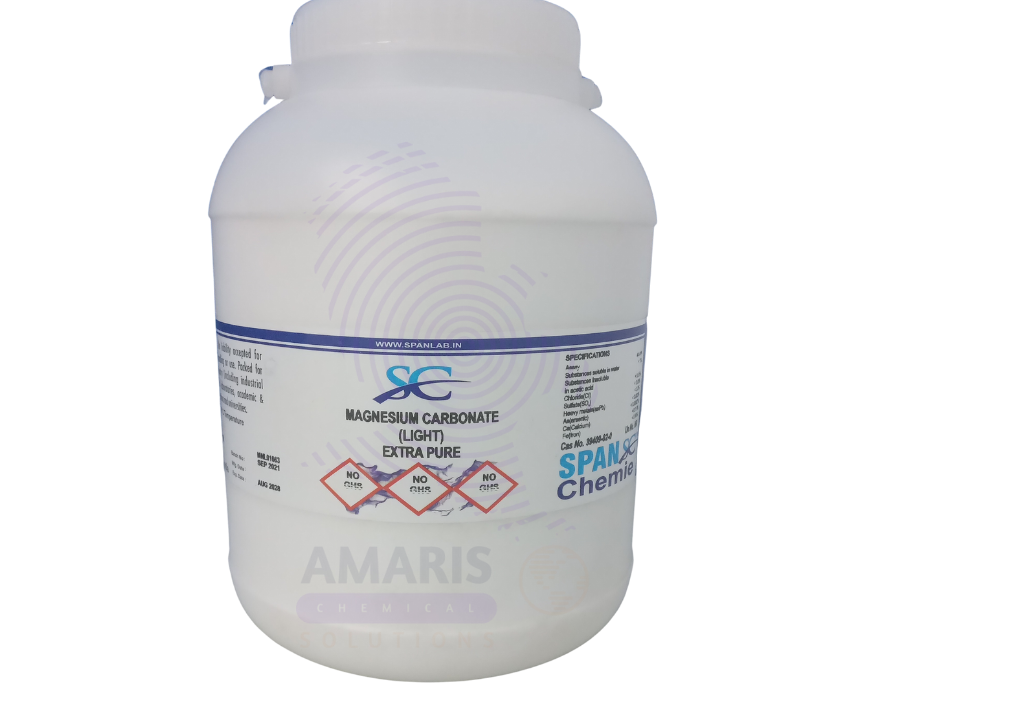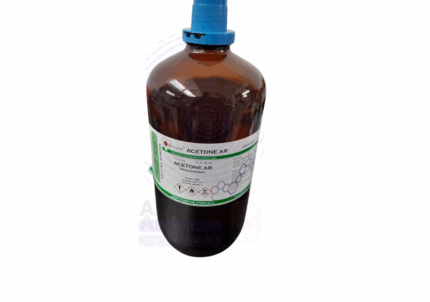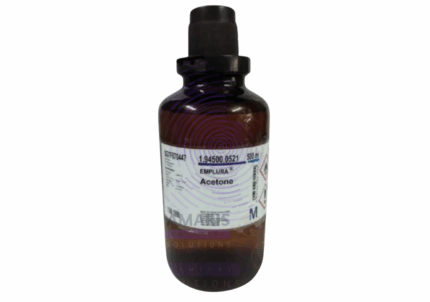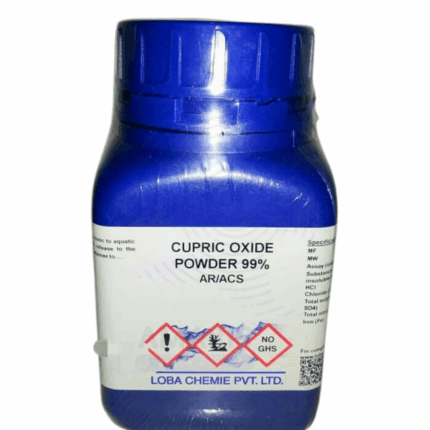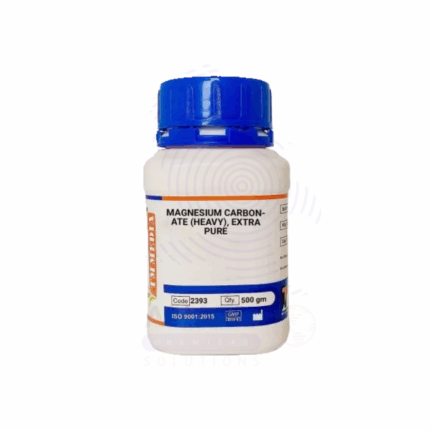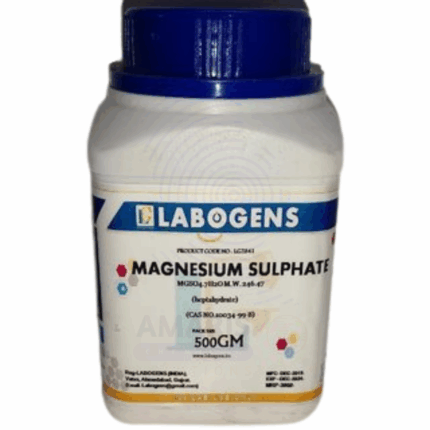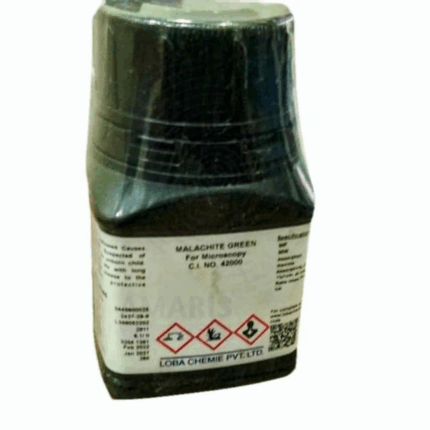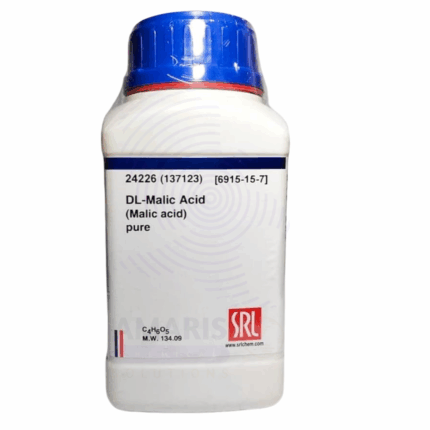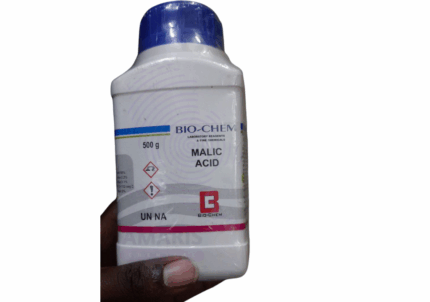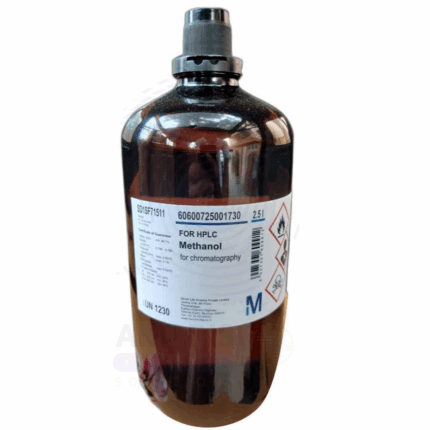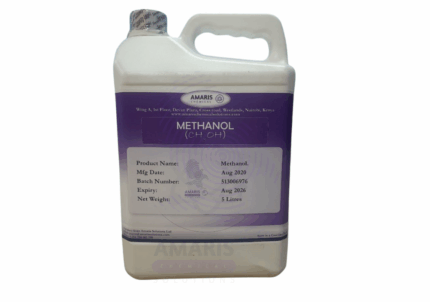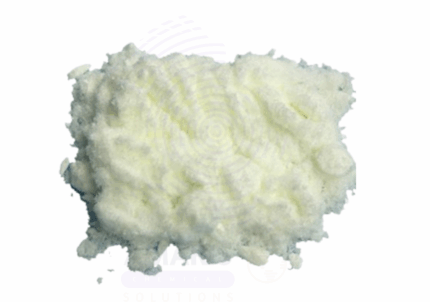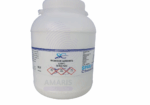

Magnesium Carbonate Light Extra Pure
$ 18.00 Original price was: $ 18.00.$ 17.89Current price is: $ 17.89.
Magnesium Carbonate Light Extra Pure is a fine, white, odorless powder known for its excellent absorbent, drying, and antacid properties. It is widely used in pharmaceutical formulations, cosmetics, food additives, and laboratory reagents. Its “light” form refers to its low bulk density, making it ideal for applications requiring a fluffy, easily dispersible powder. In personal care products, it serves as a filler and opacifier, while in pharmaceuticals, it acts as a mild antacid and magnesium supplement. Its high purity ensures consistent performance in analytical procedures and specialty chemical processes.
Magnesium Carbonate Light Extra Pure
Primary Uses
- Acid-Base Reactions:
- Frequently used in neutralization experiments to demonstrate reactions between carbonates and acids, producing CO₂.
- Drying Agent:
- Acts as a desiccant or moisture absorbent in laboratories due to its hygroscopic nature, especially in desiccators or drying tubes.
- Reagent in Inorganic Chemistry:
- Used as a source of magnesium ions (Mg²⁺) in analytical and synthesis reactions.
Secondary Uses
- Buffer Component:
- Sometimes used in buffer solutions or to maintain alkaline pH in chemical formulations.
- Preparation of Other Magnesium Compounds:
- Employed in reactions to synthesize other magnesium salts such as magnesium chloride or magnesium sulfate.
- Demonstrations and Teaching:
- Utilized in educational settings for simple reactions involving carbonates, decomposition, or thermal behavior.
| PACK SIZE |
500 grams Plastic Tin |
|---|
1. Basic Identification Attributes
- Chemical Name: Magnesium Carbonate (Light)
- Synonyms: Light Magnesium Carbonate, Magnesite (light form)
- CAS Number: 546-93-0
- Molecular Formula: MgCO₃
- Molecular Weight: 84.31 g/mol
- Appearance: White, very light, fluffy powder
- Odor: Odorless
- Solubility: Insoluble in water; soluble in dilute acids with effervescence
- Grade: Extra Pure (suitable for laboratory and analytical applications)
2. Safety & Hazard Attributes
- GHS Classification:
- Not classified as hazardous under GHS
- Hazard Statements:
- Generally considered non-toxic and safe for handling in standard lab environments
- Precautionary Statements:
- P261: Avoid inhalation of dust
- P280: Wear protective gloves/eye protection
- P305+P351+P338: If in eyes, rinse cautiously with water
- Personal Protective Equipment (PPE):
- Dust mask or respirator
- Safety goggles
- Gloves
- Lab coat
- First Aid Measures:
- Inhalation: Move to fresh air; seek medical help if symptoms occur
- Skin Contact: Wash with water
- Eye Contact: Rinse with water; seek attention if irritation persists
- Ingestion: Rinse mouth; non-toxic but medical consultation advised for large quantities
- Fire Hazards:
- Non-combustible
- Use extinguishing media suitable for surrounding fire
3. Storage & Handling Attributes
- Storage Conditions:
- Store in a tightly closed container
- Keep in a cool, dry, and well-ventilated area
- Avoid contact with acids and moisture
- Handling Tips:
- Handle in a manner that minimizes dust generation
- Use in a ventilated environment
- Wash hands thoroughly after use
4. Laboratory Applications
- Primary Uses:
- As a drying agent for gases and organic solvents
- Standard reagent in analytical chemistry and gravimetric analysis
- pH buffer component in chemical experiments
- Secondary Uses:
- Inorganic pigment base in educational and demonstration labs
- Thermal decomposition studies for CO₂ generation
- Filler or bulking agent in research formulations and inert matrices
SAFETY PRECAUTIONS
Personal Protective Equipment (PPE):
- Wear a lab coat, nitrile gloves, and safety goggles.
- Use a dust mask or operate in a fume hood to prevent inhalation of airborne particles.
Handling:
- Avoid generating or inhaling dust.
- Prevent contact with skin, eyes, and clothing.
- Wash hands thoroughly after handling.
- Use only in well-ventilated areas.
Storage:
- Store in a cool, dry, and well-ventilated location.
- Keep the container tightly sealed.
- Protect from moisture, heat, and acids.
FIRST AID MEASURES
Inhalation:
- Move to fresh air.
- Seek medical attention if breathing difficulty or irritation persists.
Skin Contact:
- Wash affected areas with soap and water.
- Remove and wash contaminated clothing.
- Seek medical advice if irritation develops.
Eye Contact:
- Rinse thoroughly with plenty of water for several minutes.
- Remove contact lenses if present and easy to do.
- Get medical attention if irritation persists.
Ingestion:
- Rinse mouth with water.
- Do not induce vomiting.
- Seek medical attention if discomfort or symptoms occur.
FIRE FIGHTING MEASURES
Flammability:
- Non-flammable under normal conditions.
- Fine dust may pose a minor explosion risk when suspended in air.
Extinguishing Media:
- Use dry chemicals, CO₂, foam, or water spray.
- Avoid water jets directly on spilled powder.
Hazardous Combustion Products:
- May emit magnesium oxides upon high-temperature decomposition.
Firefighter Protection:
- Wear self-contained breathing apparatus (SCBA) and full protective clothing.


 Preservatives(food)
Preservatives(food) Flavor Enhancers
Flavor Enhancers Acidulants
Acidulants Sweeteners
Sweeteners Antioxidants
Antioxidants Colorants(food)
Colorants(food) Nutraceutical Ingredients (food)
Nutraceutical Ingredients (food) Nutrient Supplements
Nutrient Supplements Emulsifiers
Emulsifiers
 Collectors
Collectors Dust Suppressants
Dust Suppressants Explosives and Blasting Agents
Explosives and Blasting Agents Flocculants and Coagulants
Flocculants and Coagulants Frothers
Frothers Leaching Agents
Leaching Agents pH Modifiers
pH Modifiers Precious Metal Extraction Agents
Precious Metal Extraction Agents
 Antioxidants(plastic)
Antioxidants(plastic) Colorants (Pigments, Dyes)
Colorants (Pigments, Dyes) Fillers and Reinforcements
Fillers and Reinforcements Flame Retardants
Flame Retardants Monomers
Monomers Plasticizers
Plasticizers Polymerization Initiators
Polymerization Initiators Stabilizers (UV, Heat)
Stabilizers (UV, Heat)
 Antifoaming Agents
Antifoaming Agents Chelating Agents
Chelating Agents Coagulants and Flocculants
Coagulants and Flocculants Corrosion Inhibitors
Corrosion Inhibitors Disinfectants and Biocides
Disinfectants and Biocides Oxidizing Agents
Oxidizing Agents pH Adjusters
pH Adjusters Scale Inhibitors( water)
Scale Inhibitors( water)
 Antioxidants(cosmetic)
Antioxidants(cosmetic) Emollients
Emollients Fragrances and Essential Oils
Fragrances and Essential Oils Humectants
Humectants Preservatives
Preservatives Surfactants(cosmetic)
Surfactants(cosmetic) Thickeners
Thickeners UV Filters
UV Filters
 Fertilizers
Fertilizers Soil Conditioners
Soil Conditioners Plant Growth Regulators
Plant Growth Regulators Animal Feed Additives
Animal Feed Additives Biostimulants
Biostimulants Pesticides (Herbicides, Insecticides, Fungicides)
Pesticides (Herbicides, Insecticides, Fungicides)
 Active Pharmaceutical Ingredients (APIs)
Active Pharmaceutical Ingredients (APIs) Excipients
Excipients Solvents(pharmaceutical)
Solvents(pharmaceutical) Antibiotics
Antibiotics Antiseptics and Disinfectants
Antiseptics and Disinfectants Vaccine Adjuvants
Vaccine Adjuvants Nutraceutical Ingredients (pharmaceutical)
Nutraceutical Ingredients (pharmaceutical) Analgesics & Antipyretics
Analgesics & Antipyretics
 Analytical Reagents
Analytical Reagents Solvents(lab)
Solvents(lab) Chromatography Chemicals
Chromatography Chemicals Spectroscopy Reagents
Spectroscopy Reagents microbiology-and-cell-culture-reagents
microbiology-and-cell-culture-reagents Molecular Biology Reagents
Molecular Biology Reagents Biochemical Reagents
Biochemical Reagents Inorganic and Organic Standards
Inorganic and Organic Standards Laboratory Safety Chemicals
Laboratory Safety Chemicals Specialty Laboratory Chemicals(Special Laboratory Equipment)
Specialty Laboratory Chemicals(Special Laboratory Equipment)
 Demulsifiers
Demulsifiers Hydraulic Fracturing Fluids
Hydraulic Fracturing Fluids Scale Inhibitors(oil)
Scale Inhibitors(oil) Surfactants(oil)
Surfactants(oil) Drilling Fluids
Drilling Fluids
 Dyes and Pigments
Dyes and Pigments Bleaching Agents
Bleaching Agents Softening Agents
Softening Agents Finishing Agents
Finishing Agents Antistatic Agents
Antistatic Agents
 Admixtures
Admixtures Waterproofing Agents
Waterproofing Agents Sealants and Adhesives
Sealants and Adhesives Curing Compounds
Curing Compounds Concrete Repair Chemicals
Concrete Repair Chemicals Anti-Corrosion Coatings
Anti-Corrosion Coatings
 Surfactants(cleaning)
Surfactants(cleaning) Builders
Builders Enzymes
Enzymes Solvents (Cleaning)
Solvents (Cleaning) Fragrances
Fragrances
 Electronic Chemicals
Electronic Chemicals Catalysts
Catalysts Lubricants
Lubricants Photographic Chemicals
Photographic Chemicals Refrigerants
Refrigerants Automotive chemicals
Automotive chemicals Pyrotechnic Chemicals
Pyrotechnic Chemicals
 Biodegradable Surfactants
Biodegradable Surfactants Bio-based Solvents
Bio-based Solvents Renewable Polymers
Renewable Polymers Carbon Capture Chemicals
Carbon Capture Chemicals Wastewater Treatment Chemicals
Wastewater Treatment Chemicals
 Pigments
Pigments Solvents(paint)
Solvents(paint) Specialty Coatings
Specialty Coatings Binders/Resins
Binders/Resins Additives
Additives Driers
Driers Anti-Corrosion Agents
Anti-Corrosion Agents Functional Coatings
Functional Coatings Application-Specific Coatings
Application-Specific Coatings
 Fresh Herbs
Fresh Herbs Ground Spices
Ground Spices Whole Spices
Whole Spices Spice Blends
Spice Blends Dried Herbs
Dried Herbs
 Leavening Agents
Leavening Agents Dough Conditioners
Dough Conditioners Flour Treatments
Flour Treatments Fat Replacers
Fat Replacers Decoratives
Decoratives Preservatives(baking)
Preservatives(baking)
 Plasticizers & Softeners
Plasticizers & Softeners Reinforcing Agents
Reinforcing Agents Adhesion Promoters
Adhesion Promoters Vulcanizing Agents
Vulcanizing Agents Antidegradants
Antidegradants Blowing Agents
Blowing Agents Fillers & Extenders
Fillers & Extenders Accelerators & Retarders
Accelerators & Retarders